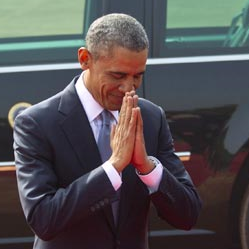Next week, Barack Obama will be the first sitting U.S. president to visit Laos, a poor, landlocked country whose large-scale efforts to dam the Mekong River threaten to destabilize the region. This concerns the United States because Southeast Asia is one of the country’s largest trading partners and a key security ally that can counterbalance China’s growing regional influence. Obama should seize this opportunity to help Laos make energy choices that, over the long term, can unify the region and preserve the Mekong.
Laos’ strategy for economic development centers on becoming the “battery of Southeast Asia” by exploiting nearly all of its massive hydropower potential on the Mekong River and its tributaries. New energy projects (nearly all large hydropower and coal) have brought in hundreds of millions of dollars of foreign direct investment annually (reaching 43 percent of the country’s total in 2015). But surprisingly little effort and underlying analysis have gone into determining whether this “all-in” approach is in the country’s best long-term interests—especially given that the dam-building, increasingly unilateral and accelerated, is upsetting Laos’ neighbors, allies, and trade partners downstream.
Recent studies (in one of which we took part) consistently show that construction of all planned dams will likely have disastrous downstream ecological and socioeconomic effects. For example, Cambodia faces losing roughly half of its fish protein, and a significant portion of Vietnam’s fertile agricultural delta may be spoiled.
Increasing trade deficits and declining foreign investment in other sectors have drawn Laos further down its current path, but it still has a choice. Our study demonstrates that reasonable incremental shifts—substituting solar, wind, and biomass energy for the most ecologically damaging dams—could produce positive economic and social gains for Laos and the region. The effects of growing demand in Laos’ urban export markets, such as Ho Chi Minh City and Bangkok, can be mitigated with this more diversified approach. It is worth noting that coal and large hydropower—reliable and cheap (at least in the short term)—do not disappear; in all the scenarios we studied, both emerge judiciously as parts of the optimal solutions.
Integrating unpredictable sources of energy such as solar and wind into an upgraded electricity grid will require advanced data monitoring and analysis—capacity that Laos lacks. Effective control and operation of its hundreds of dams, especially given seasonal flows and climate change, requires the same. The United States is uniquely well situated to help Laos build such capacity and is already positioning itself to do so, having recently begun ratcheting up its development aid to Laos and preparing to open a new USAID mission there. And because U.S. aid planners no longer build traditional infrastructure such as roads and bridges, these types of relatively low-cost information-based interventions should become these planners’ focus.
Data-driven energy planning is just a start. The region needs real dialogue among all stakeholders, not just governments, to drive negotiations on the necessary trade-offs. Regional track 1 approaches involving only governments are many—ASEAN, China’s Lancang-Mekong Cooperation Mechanism, the United States’ Lower Mekong Initiative, and so on—but there is room for the United States to start a track 2 approach, one that would allow for an open, scientific, and inclusive discussion. The weakening of the Mekong River Commission, despite its decades of good work on the equitable and sustainable use of the river’s waters, enlarges that space. For such discussions, a living model of the basin’s food, energy, and water nexus could serve as armature for better understanding and action—the IPCC process could serve as a model.
Regional politics, cronyism, and corruption remain strong forces that could overwhelm such an effort. Yet rigorous analysis underpinning inclusive regional dialogue offers a key to free the region from its prisoner’s dilemma, in which all involved will likely suffer due to a lack of coordination and trust. The stakes—stability in a strategic area and the health of one of the world’s major river systems—are too high for the United States not to engage.
Washington has a dark past in the region—its air campaign during the Vietnam War made Laos the most bombed country per capita in history and even laid the seeds for today’s dams with plans in the 1950s to “tame the Mekong.” The United States, with its strengths in science, technology, and entrepreneurship, has a brief but real opportunity to empower Laos to become a regional leader in twenty-first century energy planning and help it achieve its self-determined goals. By grasping it, Obama can leave behind the United States’ regrettable legacy and begin to deliver on the promises of the rebalance to Asia.
Source: Foreign Affairs



